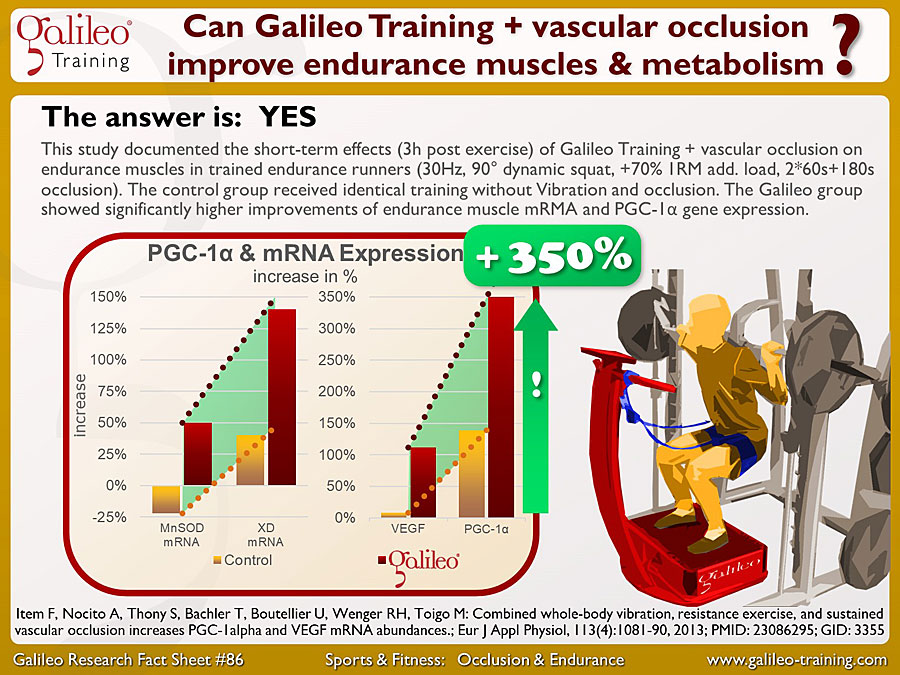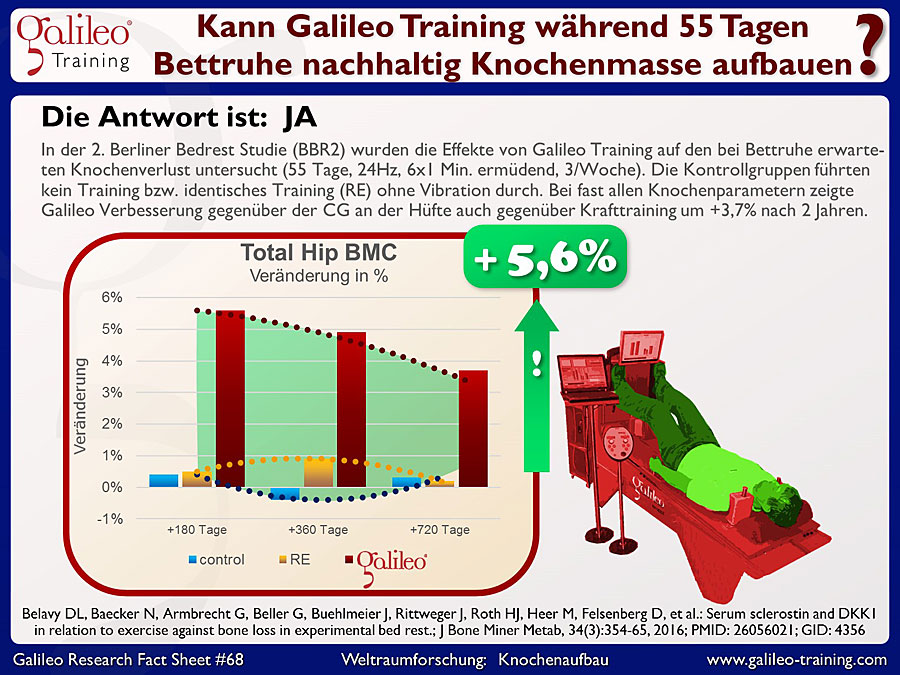This study documented the short-term effects (3h post exercise) of Galileo Training + vascular occlusion on endurance muscles in trained endurance runners (30Hz, 90° dynamic squat, +70% 1RM add. load, 2*60s+180s occlusion). The control group received identical training without Vibration and occlusion. The Galileo group showed significantly higher improvements of endurance muscle mRMA and PGC-1α gene expression...
Galileo Research Facts No. 83: Can Galileo Training be more effective to improve muscle power than vertical vibration?
This study compare Galileo Training vs vertical vibration (Power Plate) (Gal: 26Hz, 2,5mm, PP:30Hz, 4mm, static & dynamic 90° squat, 4x60-100s, 10 weeks). All three groups received upper body strength training exercises, the Galileo and Power Plate groups additional vibration training. The Galileo groups showed after 10 weeks of training the highest average improvements in muscle function and muscle power...
Galileo Research Facts No. 81: Can Galileo Training improve blood flow and exhaust the muscles?
This study reported the effects of Galileo Training at high frequencies on blood flow and NO concentration in 58-83 year old individuals (26Hz, pos. 2, 30°-40° squat, 10x30s, 60s rest). The control group performed identical exercises without vibration. The Galileo groups showed significant improvements of blood flow during the training (+15%) and significant increase of NO concentration 5 minutes after the exercise (+43%)...
Galileo Research Facts No. 79: Can Galileo Training reduce fall-risk and fracture-risk in elderly?
This study investigated the effects of 8 weeks of Galileo Training on mobility, muscle power, fall- and fracture-risk and bone parameters (age 60-80, 20Hz, pos. 3, 20° squat, 5*1min, 3/week, 8 weeks). Galileo Training improved balance (Berg Balance Scale, BBS) by 8%, muscle power (CRT) by 28%, increased flexibility (range of motion) by up to 50% and increased the Calcaneus bone quality by 0.3 SD...
Galileo Research Facts No. 78: Do higher frequencies and knee angles increase pelvic floor activation?
This study examined during Galileo Training the effects of increasing frequencies and higher squatting angles on pelvic floor activation (EMG in relation to MVC, maximum voluntary contraction) (6-26Hz, 20°-40° squat, Pos. 3). The study shows that increasing knee angles and especially increasing frequencies significantly increase pelvic floor muscle activation up to 15%...
Galileo Research Facts No. 77: Can 3 minutes Galileo Training decrease side differences in one-legged jumping?
This Study investigated the immediate effects of Galileo Training on the side-differences in one-legged jumping (26Hz, pos. 3, 3 min., bilateral 90° squats, both feet or only one foot on Galileo). The control group performed the identical exercise without vibration. Bilateral Galileo training improved jumping height of the stronger leg, one legged training focused on the weaker leg and decreased the side-difference by 12%...
Galileo Research Facts No. 69: Can Galileo Training during 55 days bed rest improve muscle function?
In the 2nd Berlin Bedrest Study (BBR2) the effects of Galileo Training against the expected bone loss was tested (55 days, 24Hz, 6x1 min. exhaustive, 3/week). The control groups receive no training or identical training with-out vibration (RE). Galileo showed in almost all. In many aspects of muscle function Galileo Training was most effective to compensate effects of bed rest in some aspects it could even improve function...
Galileo Research Facts No. 68: Can Galileo Training during 55 days bedrest improve long-term bone mass?
In the 2nd Berlin Bedrest Study (BBR2) the effects of Galileo Training against the expected bone loss was tested (55 days, 24Hz, 6x1 min. exhaustive, 3/week). The control groups receive no training or identical training with-out vibration (RE). Galileo showed in almost all bone parameters improvements vs. control and e.g. in total hip BMC even vs. RE with improvements of up to +5.6% after half a year and still +3,7% after 2 years after bedrest...
Galileo Research Facts No. 65: Can 7 minutes Galileo Training change the hormonal profile?
Diese Studie untersuchte den Effekt von lediglich 7 * 60 Sekunden Galileo Training auf die Sprungleistung und Hormonantwort (7 * 60 Sek., 30Hz, Pos. 5, 90° Kniebeuge). Das Galileo Training erhöhte die Spitzenleistung und Spitzensprunghöhe bei wiederholten Sprüngen um bis zu 13% und reduzierte Testosteron und Cortisol um bis zu 27% und zeigte somit Reaktionen analog zu intensivstem Krafttraining...
Galileo Research Facts No. 61: Are 5 minutes Galileo Mano Training (dumbbell) an effective warm up Training?
This study reported the warming up effects of 5 minutes Galileo Mano Training (Galileo vibrating dumbbell) compared to static exercises and arm ergometer training (5*1 min, 26Hz, 5 Exercises). The control groups performed the exercises without vibration or used an arm ergometer (5 Min., 25 W, 25 rpm). Only the Galileo group showed significant improvements in EMG intensity and peak power output of up to 6%...









